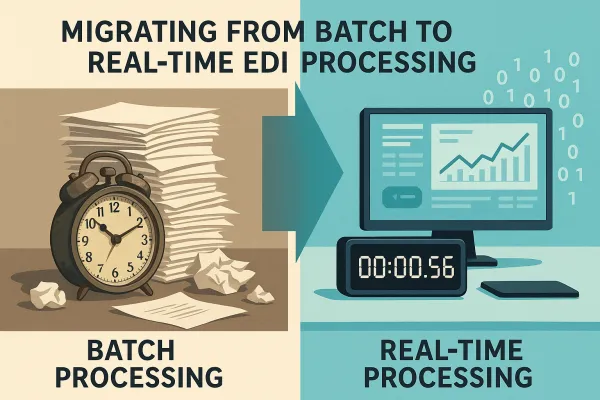The Complete EDI Emergency Response Framework: Rapid Containment Strategies for Zero-Day Attacks and Supply Chain Compromises in 2025

When an advanced persistent threat group successfully penetrated Cisco's ASA devices through zero-day vulnerabilities in early September 2025, CISA issued Emergency Directive ED 25-03 requiring federal agencies to identify, analyze, and mitigate potential compromises immediately, after adding vulnerabilities CVE-2025-20333 and CVE-2025-20362 to the Known Exploited Vulnerabilities Catalog. The attackers had already demonstrated the ability to exploit zero-day vulnerabilities that persist through reboots and system upgrades, forcing agencies to collect and transmit memory files to CISA for forensic analysis by 11:59 p.m. EST Sept. 26.
This scenario illustrates why traditional IT incident response frameworks fail catastrophically when EDI systems face active cyber attacks. While your network team scrambles to patch firewalls, your supply chain operations continue processing purchase orders, advance shipping notices, and invoices through potentially compromised channels. EDI systems open the door to various security threats that could compromise sensitive business data, and EDI flows with less protected subcontractors can be privileged entry points for attackers.
The 2025 threat landscape has fundamentally shifted. Cybercrime grew in both frequency and sophistication, marked by ransomware attacks, AI-enhanced tactics and a notable increase in supply chain attacks. Vendors and contractors remain vulnerable entry points, enabling attackers to exploit trusted relationships to compromise downstream organizations. When attackers compromise one trading partner, they can leverage EDI connections to move laterally across your entire supplier network.
Essential Components of an EDI Emergency Response Framework
An effective EDI emergency response framework operates differently from standard IT incident response because EDI systems bridge internal operations with external trading partners. Your framework needs immediate threat detection specifically designed for EDI protocols, not just network monitoring.
Start with EDI-specific threat detection that monitors AS2 connections, SFTP sessions, and VAN communications for unusual patterns. Configure alerts for connection attempts from unauthorized IP addresses, unexpected document types, or transaction volumes that deviate significantly from historical baselines. Many EDI managers overlook monitoring outbound connections, but attackers often use compromised EDI systems to establish persistence through seemingly legitimate document exchanges.
Trading partner notification becomes critical during active attacks. Pre-drafted communication templates save precious minutes when you need to inform partners about potential compromises without creating panic. Your templates should include technical details about affected document types, alternative communication channels, and estimated restoration timelines. Transport management systems like Oracle TM, SAP TM, or Cargoson often integrate directly with EDI systems, so your notification procedures must account for these dependencies.
Business continuity procedures for EDI attacks require fallback options that don't depend on your primary infrastructure. Establish agreements with trading partners for emergency communication through secure email, dedicated phone lines, or alternative EDI providers. Document manual processes for critical transactions like urgent purchase orders or shipping notifications. Ransomware attacks have compromised supply chain automation solutions, affecting inventory management, order processing and logistics systems.
Your framework must also address the cascade effect when attacks spread through EDI connections. There is precedent for hackers leveraging an attack on an EDI provider to get to its customers, with an attack on an EDI provider in 2018 impacting at least four U.S. pipeline companies. Plan for scenarios where your trading partners' systems are compromised and could potentially infect your environment through trusted EDI connections.
The 4-Phase EDI Emergency Response Methodology
Phase 1: Rapid Assessment (0-30 minutes) focuses on determining attack scope within your EDI infrastructure. Check all active AS2 connections, VAN sessions, and direct partner connections for signs of compromise. Review EDI transaction logs for the past 48 hours, looking for unusual document types, unexpected trading partner IDs, or failed authentication attempts that might indicate reconnaissance activity. Deploy your EDI monitoring tools to capture real-time connection data.
Query your EDI translation software for any recently processed documents that contain suspicious content or originate from compromised trading partners. Many attacks embed malicious payloads within legitimate EDI transaction sets, exploiting custom mapping logic to execute code during document processing. Check integration points between your EDI platform and ERP systems for unauthorized data access.
Phase 2: Containment (30 minutes-2 hours) requires immediate isolation of affected EDI connections without completely shutting down critical supply chain operations. Implement connection-level filtering to block traffic from compromised trading partners while maintaining communications with verified secure partners. Your EDI firewall rules should allow you to quarantine specific AS2 stations or SFTP connections without affecting the entire EDI infrastructure.
Coordinate with your VAN provider to implement emergency traffic filtering if attacks are propagating through value-added network services. Document all containment actions with timestamps and affected trading partner details for later investigation. Deploy backup EDI processing nodes if your primary systems show signs of compromise.
Phase 3: Business Continuity (2-24 hours) maintains supply chain operations through alternative channels while your primary EDI systems remain compromised. Activate manual processing procedures for time-critical documents like advance shipping notices and electronic invoices. Notify key trading partners about temporary communication procedures and provide alternative contact methods.
Coordinate with integrated systems including transport management platforms. Whether you're using MercuryGate, Descartes, Blue Yonder, or Cargoson, ensure these systems can operate independently of compromised EDI connections. Some TMS platforms cache EDI data locally, allowing continued operations even when EDI communications are disrupted.
Phase 4: Recovery and Hardening (24+ hours) focuses on safely restoring EDI operations while implementing additional security measures. Rebuild compromised EDI translation maps from clean backups, ensuring no malicious code persists in custom mapping logic. Update AS2 certificates, SFTP keys, and VAN credentials for all trading partner connections.
Test restored connections with a subset of trusted trading partners before enabling full operations. Deploy additional monitoring for previously compromised connections, including enhanced logging and behavioral analysis. Update your EDI security policies based on lessons learned from the attack.
Zero-Day Attack Response Procedures for EDI Systems
Zero-day attacks targeting EDI systems exploit previously unknown vulnerabilities in EDI translation software, AS2 clients, or integration platforms. These vulnerabilities persist through reboots and system upgrades, making traditional patch-and-restart approaches ineffective.
When facing zero-day EDI vulnerabilities, immediately isolate affected systems at the network level while maintaining critical business operations through backup channels. Contact your EDI software vendors directly rather than waiting for public patch announcements. Major EDI providers like IBM Sterling, Cleo, TrueCommerce, and SPS Commerce maintain emergency response teams for critical security issues.
Implement emergency patch management procedures specifically for EDI infrastructure. Unlike standard application patches, EDI updates often require coordination with trading partners who may use incompatible versions. Establish a test environment that mirrors your production EDI setup, including connections to willing trading partner test systems. Validate that emergency patches don't break existing document mappings or introduce new compatibility issues.
Coordinate with transport management system vendors if attacks target integrated platforms. Oracle TM, SAP TM, Blue Yonder, and Cargoson all maintain security teams that can provide guidance on isolating compromised integrations. Document all vendor communications and patch deployment activities for post-incident analysis.
Supply Chain Compromise Response Protocols
The digital ecosystem has become so densely interconnected that a single compromised supplier can trigger systemic disruption across entire sectors. When trading partners' systems are compromised, the attack can spread through legitimate EDI connections, making detection extremely difficult.
Develop procedures for identifying when trading partners' EDI systems are compromised. Monitor for unusual document patterns, unexpected transaction volumes, or documents containing suspicious data elements. If no one is safe from a cyber-attack, then the multiplication of EDI flow increases the vulnerability of a company. Indeed, EDI flows with less protected subcontractors can be privileged entry points for attackers.
Establish secure alternative communication channels for critical trading partners during EDI outages. These might include encrypted email, dedicated secure portals, or emergency phone trees. Document these procedures in your trading partner agreements so partners understand fallback procedures before emergencies occur.
Manage cascading impacts across your supply chain network by prioritizing communications with tier-one suppliers and customers. Integrate critical suppliers into incident response exercises and ensure that contractual agreements specify roles, responsibilities, and notification timelines. Your response must account for the domino effect when compromised partners spread attacks to their other trading relationships.
Transport management systems require special attention during supply chain compromises. Whether using MercuryGate, Descartes, or Cargoson, these platforms often aggregate data from multiple EDI partners. A single compromised trading partner could potentially inject malicious data that affects shipment routing, carrier selection, or freight auditing across your entire logistics network.
Testing and Maintaining Your EDI Emergency Response Framework
Quarterly tabletop exercises specifically designed for EDI environments help identify gaps in your response procedures before real attacks occur. Unlike generic IT security exercises, EDI scenarios must account for business continuity requirements and trading partner dependencies. Regularly run tabletop exercises with key stakeholders and include scenarios for supply chain and ransomware attacks.
Design exercises around realistic EDI attack vectors: compromised AS2 stations injecting malicious documents, VAN providers experiencing security breaches, or trading partners' systems being used to spread malware through legitimate EDI connections. Include representatives from procurement, logistics, customer service, and finance teams who depend on EDI operations for daily activities.
Integration testing with major TMS platforms ensures your emergency procedures work with existing logistics technology. Test failover procedures between your primary EDI environment and backup systems while maintaining connections to transport management platforms. Verify that systems like Oracle TM, SAP TM, Blue Yonder, or Cargoson can continue processing shipment data when EDI communications are disrupted.
Update procedures based on emerging threat intelligence specific to EDI and supply chain attacks. Develop and regularly test robust incident response plans. Subscribe to security bulletins from CISA, your EDI software vendors, and industry associations. 72% of respondents to the Global Cybersecurity Outlook survey reported a rise in cyber risks, with cybercrime growing in both frequency and sophistication.
Staff training requirements should include both technical and business teams. EDI administrators need training on threat detection and containment procedures, while business users need guidance on manual fallback procedures. Cross-train multiple employees on critical EDI operations to avoid single points of failure during emergency response.
Implementation Resources and Next Steps
Start implementing your EDI emergency response framework by conducting a baseline assessment of your current EDI security posture. Document all trading partner connections, integration points with transport management systems, and dependencies on EDI for critical business processes.
Develop communication templates for different attack scenarios, including trading partner notifications, internal status updates, and coordination with EDI vendors. Test alternative communication channels with key trading partners before you need them in an emergency.
Consider engaging with specialized EDI security consultants who understand the unique challenges of protecting supply chain communications. Your framework should integrate with existing incident response procedures while addressing the specific requirements of EDI operations and trading partner relationships.
The cybersecurity landscape will continue evolving throughout 2025, with cyberattacks hitting airlines, automakers, banks, and even city services, causing major disruptions and exposing sensitive data, showing how businesses across every sector remain prime targets. Your EDI emergency response framework requires regular updates as new threats emerge and your supply chain relationships evolve.





